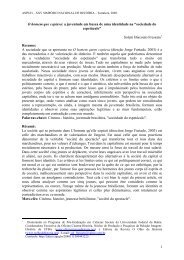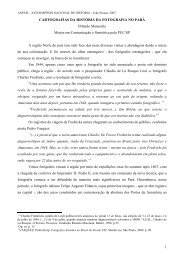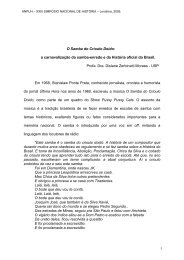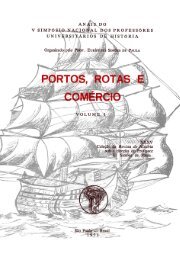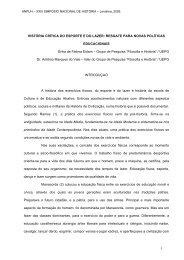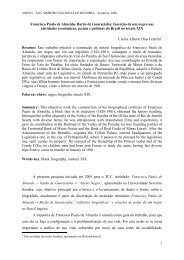- Page 1 and 2:
1 9 6 2 I I SIMPÓSIO DOS PROFESSÔ
- Page 3:
ERRATA Pg. 197 - linha 15, leia-se
- Page 7:
I Promoção do Simpósio
- Page 10 and 11:
6 COMISSAO ORGANIZADORA Diretoria d
- Page 12 and 13:
9 horas - 3.- SessAo de Estudos. Tt
- Page 15 and 16:
Constantino, Marta Clara R. T. - Ma
- Page 17 and 18:
SOuto, Amérlco da Costa - Curitlba
- Page 19 and 20:
PARANA Aguiar, Antônio Cardoso Bal
- Page 21 and 22:
Matos, Odilon Nogueira de Melo, Clo
- Page 23 and 24:
REGULAMENTO DO II SIMPóSIO DOS PRO
- Page 25 and 26:
§ único - Em qualquer caso, as mo
- Page 27 and 28:
talvez tenhamos apenas, e comodamen
- Page 30 and 31:
Curitiba, 31 de outubro de 1962. a)
- Page 32 and 33:
MOÇAO N.o 7 Os professõres partic
- Page 34 and 35:
Amália Hermano Teixeira Maria Jos
- Page 36 and 37:
seus eminentes Professôres, na pes
- Page 38 and 39:
MQÇAO N.o 16 Os abaixo-assinados,
- Page 41 and 42:
MOQAO N.o 21 Que seja enviado ao Di
- Page 43 and 44:
EXPOSIÇAO DE CARTOGRAFIA HISTóRIC
- Page 45:
II Comunicações
- Page 48:
giea da História", isto é, a Filo
- Page 51 and 52:
pria fôrça e já não queriam obe
- Page 53 and 54:
mo no comunismo, porque "o Socialis
- Page 57:
Ao Prol. Miguel Sehall: - Em nossa
- Page 60 and 61:
Devia escolher dentro do temário p
- Page 62 and 63:
Para encerrar êste capítulo, deve
- Page 64:
PROPRIEDADE COMUNITARIA OU DE CARAT
- Page 67 and 68:
property. He presents the three kin
- Page 69 and 70:
3 - Elogio à expressão "realmente
- Page 71:
2 - Sugere a forma Frederico Barbar
- Page 74 and 75:
Ao Prol. Pedro Calmon: Agradece a i
- Page 76 and 77:
cedentes medievais e suas sobreviv
- Page 79 and 80:
do pessoalmente, ou baseando-se em
- Page 81 and 82:
ção a parte a), do trabalho dos p
- Page 83 and 84:
sideração dos mecanismos de conti
- Page 85 and 86:
Teme as conseqüências de uma posi
- Page 87:
RESPOSTAS DO PROF. GUY DE HOLLANDA:
- Page 91 and 92:
publicus, com a conivência dos mag
- Page 93 and 94:
A Africa do Norte pode servir de ex
- Page 95 and 96:
vam em sangrentas repressões, com
- Page 98:
Já verificamos o regime de terras
- Page 101 and 102:
ém um aspecto patriarcal em que o
- Page 104 and 105:
Na América, e em especial no Brasi
- Page 106 and 107:
sidade. Porém, o Autor não acentu
- Page 108 and 109:
Na verdade, todos os políticos vis
- Page 110 and 111:
Ao Prol. Pedro Freire Ribeiro: Não
- Page 112 and 113:
A Prola. Maria da Glória Alves Por
- Page 115 and 116:
PROBLEMAS JURíDICO-SOCIAIS DO ESTA
- Page 117 and 118:
poneses (dihqãns) como auxiliares
- Page 119 and 120:
tornou-se a aplicação dêstes pri
- Page 121 and 122:
considerado pessoa de vontade próp
- Page 123 and 124:
Os proprietãrios tendiam a ampliar
- Page 125 and 126:
Em conclusão, podemos ver que, se
- Page 127 and 128:
are the "hima"; others are kept by
- Page 129 and 130:
geral dos bens, de seitas de carát
- Page 131 and 132:
técnicas, após a chegada dos turc
- Page 133:
CONTRIBUIÇAO AO ESTUDO DA HISTÓ'R
- Page 136 and 137:
é um fato muito importante. O Cons
- Page 138 and 139:
de penúria, vivendo de pequenas pl
- Page 140 and 141:
Quando o gado se multiplicava, o se
- Page 142 and 143:
Nos inventários das famílias faze
- Page 144 and 145:
1820, e Etienne de Rencourt em 1900
- Page 146 and 147:
Tôda a estrutura social e econômi
- Page 148 and 149:
que aumentava o novo modo de uso da
- Page 150 and 151:
Municipal daquela cidade informava
- Page 153 and 154:
valor que tem naturalmente tomado o
- Page 157 and 158:
(9) Saint-Hilaire - "L'Agriculture
- Page 159:
(56) Carta do Barão do Tibagi, Ms.
- Page 162 and 163:
1: fácil compreender que uma regi
- Page 164 and 165:
Ainda para facUltar a vinda de colo
- Page 166 and 167:
de Catarina li, princêsa 'alemã d
- Page 169 and 170: As autoridades alimentavam esperan
- Page 171 and 172: a principio de Maio, quando era imp
- Page 173 and 174: tste fato é de grande significaç
- Page 176 and 177: 3 mil litros diários de leite. A p
- Page 178 and 179: am na Cooperativa Batavo de Carambe
- Page 180: tados a melhor prêço, associaram-
- Page 183 and 184: pois acreditam que qualquer modalid
- Page 185 and 186: gem de novas iniciativas, oficiais
- Page 187: de realizar comparações entre a c
- Page 190 and 191: processo de miscegenação, gerando
- Page 192 and 193: das produzidas pela compra e venda
- Page 194 and 195: saltam as fazendas e as tropas de m
- Page 196: Ao Prol. Pedro Calmon: O argumento
- Page 201 and 202: catória que dividia as terras port
- Page 203 and 204: per1or, Conselho de Pesquisas da Un
- Page 205 and 206: como nos diversos niveis das trinch
- Page 207 and 208: guas abaixo da colonia Thereza. Tem
- Page 209: Fig. 1 - Levantamento parcial da pl
- Page 213: Fig. 4 - Detalhe das escavações.
- Page 217: Fig. 8 - Mó ou pedra de amolar. Fi
- Page 222 and 223: FONTES Childe, V. Gordon - 1960 - O
- Page 224 and 225: Acontece, porém, que de acôrdo co
- Page 227 and 228: A PROPRIEDADE RURAL PARAGUAIA E A D
- Page 229 and 230: panhola afirma: "Esa política se l
- Page 231 and 232: a mensagem trazida pelo caracará p
- Page 234 and 235: Transcrevemos na integra o document
- Page 236 and 237: (3) - Sarrailh, Jean - ibid, pago 5
- Page 238 and 239: Como explicaria, então, o paradoxo
- Page 241 and 242: A OCUPAÇAO DA TERRA NO NORDESTE BA
- Page 243: das consideradas de dimensões norm
- Page 247 and 248: QUADRO N.o 3 Localização e área
- Page 249 and 250: locais. Em 11 das fazendas visitada
- Page 251 and 252: por 300 léguas, incluindo em seu e
- Page 254: se tivesse de confinar-se aos limit
- Page 257 and 258: Há, todavia, exceções. Uma delas
- Page 259 and 260: subjacentes no quanto foi escrito.
- Page 262 and 263: areas sh011ld aim at the securing o
- Page 264 and 265: neros e do numerário, a deserção
- Page 266 and 267: Note-se que a palavra "sesmeiro", n
- Page 268 and 269: cianos, em trocas de outras terras
- Page 270 and 271:
ai logo distribuiu sesmarias Estêv
- Page 273 and 274:
das aldeias dos indios, como se pre
- Page 275 and 276:
estabilidade, como também pelos mu
- Page 277 and 278:
Que o problema continuava em discus
- Page 279 and 280:
11 - Sesmarias in the criticism of
- Page 281 and 282:
27) - Cf. o Tombo ou Cópia fiel da
- Page 283 and 284:
citara no inicio do seu trabalho a
- Page 285 and 286:
concessões de terras, feitas em to
- Page 287 and 288:
de volumes para os quais não há r
- Page 289 and 290:
Ao Prof. Francisco Iglésias: As do
- Page 291 and 292:
COLONIAS DE PARCERIA NA LAVOURA DE
- Page 293 and 294:
promover a formação de núcleos c
- Page 295 and 296:
nossas rendas não permitem grandes
- Page 297 and 298:
dos sob os diversos sistemas, não
- Page 299 and 300:
e ao mesmo tempo facultou-lhes plan
- Page 301 and 302:
sada a colheita não queriam ocupar
- Page 303 and 304:
seu funcionamento e finalmente fala
- Page 305 and 306:
os, a constituição artificial das
- Page 307 and 308:
sacado e finalmente transportado at
- Page 309 and 310:
Art. 6 Vendido o café pelo !lmo. e
- Page 311 and 312:
muita discussão sôbre a região e
- Page 313 and 314:
(24) Discurso do Dr. José Antonio
- Page 315 and 316:
(37) Em 3 de abril de 1854 escrevia
- Page 317 and 318:
mo que houvesse algum exagêro de p
- Page 319:
taxa por cabeça e a recusa a resti
- Page 322 and 323:
fazenda e o restante às despesas f
- Page 324 and 325:
Do Prol. José Roberto do Amaral La
- Page 326 and 327:
Ao Prol. Nilo Garcia: Não há dúv
- Page 328 and 329:
trabalho vultoso e complexo. Temos
- Page 330 and 331:
Nos primeiros tempos da colônia, e
- Page 332 and 333:
5 - Que o sistema de comercializaç
- Page 334 and 335:
150 mil metros quadrados. Quanto ao
- Page 336 and 337:
Mas por demais se diferencia dêste
- Page 338 and 339:
vinha para fixar-se, instituir fam
- Page 340 and 341:
d) Uso da Terra Nas terras desta da
- Page 342 and 343:
o fato que se registra é tanto mai
- Page 346 and 347:
EVOLUTION OF THE PROPERTY AND USE O
- Page 348 and 349:
A Profa. Alice P. Canabrava: A dist
- Page 350 and 351:
A geração que o alcançou no fim
- Page 352 and 353:
Dois hectares de terra bem irrigada
- Page 354 and 355:
Para os seus contemporâneos êle d
- Page 357:
Primeira página do estudo "O Baixo
- Page 361:
primeira página do estudo "Vale do
- Page 365 and 366:
ANEXOS o BAIXO ASSú A grande verte
- Page 367 and 368:
1 - que defendia a tese de que Joaq
- Page 369 and 370:
íNDICE Págs. I PROMOÇAO DO SIMP
- Page 374:
IMPRENSA DA UNIVERSIDADE DO PARANÁ






